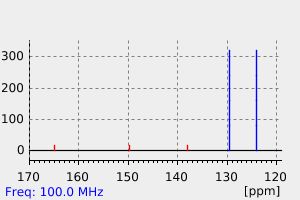N-氯-4-硝基苯甲酰胺 | 16192-51-1
中文名称
N-氯-4-硝基苯甲酰胺
中文别名
——
英文名称
N-chloro-4-nitrobenzamide
英文别名
N-chloro-p-nitrobenzamide;4-Nitrobenzhydroxamic acid chloride
CAS
16192-51-1
化学式
C7H5ClN2O3
mdl
——
分子量
200.581
InChiKey
OEVDDGXILDFOEL-UHFFFAOYSA-N
BEILSTEIN
——
EINECS
——
-
物化性质
-
计算性质
-
ADMET
-
安全信息
-
SDS
-
制备方法与用途
-
上下游信息
-
文献信息
-
表征谱图
-
同类化合物
-
相关功能分类
-
相关结构分类
物化性质
-
密度:1.469±0.06 g/cm3(Predicted)
计算性质
-
辛醇/水分配系数(LogP):2
-
重原子数:13
-
可旋转键数:1
-
环数:1.0
-
sp3杂化的碳原子比例:0.0
-
拓扑面积:74.9
-
氢给体数:1
-
氢受体数:3
SDS
上下游信息
反应信息
-
作为反应物:描述:N-氯-4-硝基苯甲酰胺 在 sulfur 作用下, 生成 N,N'-bis-(4-nitro-benzoyl)-sulfur diimide参考文献:名称:Borovikova,G.S. et al., Journal of Organic Chemistry USSR (English Translation), 1979, vol. 15, p. 424 - 429摘要:DOI:
-
作为产物:参考文献:名称:通过C–H激活直接访问钴环化合物:启用N-氯酰胺的杂环的室温合成摘要:首次通过C–H活化合成钴环化合物,提供了对钴催化化学的关键机理的见解。N-氯酰胺用作钴催化的室温C–H活化和杂环构建的直接合成子。炔烃作为偶联伙伴可以方便地获得异喹诺酮,这是一类重要的合成和药学上重要的化合物。广泛的底物范围使得可以将各种各样的取代模式结合到杂环支架中。DOI:10.1021/acs.orglett.7b02632
文献信息
-
Photochemical transformations. Part XXXII. Photolysis of thiobenzoic acid O-esters. Part III. Photolysis of O-phenethyl thiobenzoates and other thiobenzoates作者:Derek H. R. Barton、Michael Bolton、Philip D. Magnus、Keshav G. Marathe、Gerald A. Poulton、Peter J. WestDOI:10.1039/p19730001574日期:——Homoallylic alcohols can be dehydrated under exceptionally mild conditions by conversion into their thiobenzoate O-esters and irradiation between –70° and room temperature. A variety of substrates have been dehydrated by this method.
-
N-氯代酰胺的室温C-H活化/环化级联反应合成异喹啉酮衍生物的方法
-
Cobalt(III)-Catalyzed [4 + 2] Annulation of <i>N</i>-Chlorobenzamides with Maleimides作者:Nachimuthu Muniraj、Kandikere Ramaiah PrabhuDOI:10.1021/acs.orglett.8b04117日期:2019.2.15A Co(III)-catalyzed novel [4 + 2] annulation of N-chlorobenzamides with maleimides has been reported. Mostly, maleimides are known to furnish the Michael-type or 1,1-type cyclized products while treating with amides. In this reaction, maleimides furnished [4 + 2] annulated products in good yields at room temperature while being treated with the internal oxidizing N-chlorobenzamide as a directing group
-
Cobalt(<scp>iii</scp>)-catalyzed redox-neutral [4+2]-annulation of <i>N</i>-chlorobenzamides/acrylamides with alkylidenecyclopropanes at room temperature作者:Balu Ramesh、Masilamani JeganmohanDOI:10.1039/d1cc00654a日期:——An efficient synthesis of substituted 3,4-dihydroisoquinolinones through [4+2]-annulation of N-chlorobenzamides/acrylamides having a monodentate directing group with alkylidenecyclopropanes in the presence of a less expensive, highly abundant and air stable Co(III) catalyst via a C–H activation is demonstrated. In this reaction, the N–Cl bond of N-chlorobenzamide serves as an internal oxidant and thus
-
Reaction of Nitrile Oxides with<i>N</i>-Aryl-<i>S</i>,<i>S</i>-dimethylsuIfimides作者:Shinsaku Shiraishi、Tadashi Shigemoto、Shojiro OgawaDOI:10.1246/bcsj.51.563日期:1978.2Both benzimidazole 3-oxides and 1,2,4-benzoxadiazines were formed in reactions of sterically-stabilized benzonitrile oxides with N-aryl-S,S-dimethylsulfimides, whereas only 1,2,4-benzoxadiazines were produced in reactions of 2,6-unsubstituted benzonitrile oxides. The reactions are thought to proceed via the intermediacy of a nitroso compound formed by the nucleophilic attack of sulfimide on the carbon苯并咪唑 3-氧化物和 1,2,4-苯并恶二嗪均在空间稳定的苯甲腈氧化物与 N-芳基-S,S-二甲基亚砜的反应中形成,而在 2 的反应中仅产生 1,2,4-苯并恶二嗪, 6-未取代的苄腈氧化物。该反应被认为是通过亚硝基化合物的中间作用进行的,亚硝基化合物是由亚砜亲核攻击氧化腈的碳原子和随后释放二甲基硫醚形成的。该中间体的亚硝基的氮或氧原子可以攻击源自磺酰亚胺的苯环的邻位分别形成苯并咪唑3-氧化物或1,2,4-苯并恶二嗪,亚硝基与C共轭对于衍生自 2,6-未取代的氧化苄腈的中间体,-芳基可以以顺式形式获得,因此,发生独特的 O-攻击以提供 1,2,4-苯并恶二嗪。另一方面,不能考虑亚硝基与 C-芳基的共轭...
表征谱图
-
氢谱1HNMR
-
质谱MS
-
碳谱13CNMR
-
红外IR
-
拉曼Raman
-
峰位数据
-
峰位匹配
-
表征信息
同类化合物
(βS)-β-氨基-4-(4-羟基苯氧基)-3,5-二碘苯甲丙醇
(S,S)-邻甲苯基-DIPAMP
(S)-(-)-7'-〔4(S)-(苄基)恶唑-2-基]-7-二(3,5-二-叔丁基苯基)膦基-2,2',3,3'-四氢-1,1-螺二氢茚
(S)-盐酸沙丁胺醇
(S)-3-(叔丁基)-4-(2,6-二甲氧基苯基)-2,3-二氢苯并[d][1,3]氧磷杂环戊二烯
(S)-2,2'-双[双(3,5-三氟甲基苯基)膦基]-4,4',6,6'-四甲氧基联苯
(S)-1-[3,5-双(三氟甲基)苯基]-3-[1-(二甲基氨基)-3-甲基丁烷-2-基]硫脲
(R)富马酸托特罗定
(R)-(-)-盐酸尼古地平
(R)-(-)-4,12-双(二苯基膦基)[2.2]对环芳烷(1,5环辛二烯)铑(I)四氟硼酸盐
(R)-(+)-7-双(3,5-二叔丁基苯基)膦基7''-[((6-甲基吡啶-2-基甲基)氨基]-2,2'',3,3''-四氢-1,1''-螺双茚满
(R)-(+)-7-双(3,5-二叔丁基苯基)膦基7''-[(4-叔丁基吡啶-2-基甲基)氨基]-2,2'',3,3''-四氢-1,1''-螺双茚满
(R)-(+)-7-双(3,5-二叔丁基苯基)膦基7''-[(3-甲基吡啶-2-基甲基)氨基]-2,2'',3,3''-四氢-1,1''-螺双茚满
(R)-(+)-4,7-双(3,5-二-叔丁基苯基)膦基-7“-[(吡啶-2-基甲基)氨基]-2,2”,3,3'-四氢1,1'-螺二茚满
(R)-3-(叔丁基)-4-(2,6-二苯氧基苯基)-2,3-二氢苯并[d][1,3]氧杂磷杂环戊烯
(R)-2-[((二苯基膦基)甲基]吡咯烷
(R)-1-[3,5-双(三氟甲基)苯基]-3-[1-(二甲基氨基)-3-甲基丁烷-2-基]硫脲
(N-(4-甲氧基苯基)-N-甲基-3-(1-哌啶基)丙-2-烯酰胺)
(5-溴-2-羟基苯基)-4-氯苯甲酮
(5-溴-2-氯苯基)(4-羟基苯基)甲酮
(5-氧代-3-苯基-2,5-二氢-1,2,3,4-oxatriazol-3-鎓)
(4S,5R)-4-甲基-5-苯基-1,2,3-氧代噻唑烷-2,2-二氧化物-3-羧酸叔丁酯
(4S,4''S)-2,2''-亚环戊基双[4,5-二氢-4-(苯甲基)恶唑]
(4-溴苯基)-[2-氟-4-[6-[甲基(丙-2-烯基)氨基]己氧基]苯基]甲酮
(4-丁氧基苯甲基)三苯基溴化磷
(3aR,8aR)-(-)-4,4,8,8-四(3,5-二甲基苯基)四氢-2,2-二甲基-6-苯基-1,3-二氧戊环[4,5-e]二恶唑磷
(3aR,6aS)-5-氧代六氢环戊基[c]吡咯-2(1H)-羧酸酯
(2Z)-3-[[(4-氯苯基)氨基]-2-氰基丙烯酸乙酯
(2S,3S,5S)-5-(叔丁氧基甲酰氨基)-2-(N-5-噻唑基-甲氧羰基)氨基-1,6-二苯基-3-羟基己烷
(2S,2''S,3S,3''S)-3,3''-二叔丁基-4,4''-双(2,6-二甲氧基苯基)-2,2'',3,3''-四氢-2,2''-联苯并[d][1,3]氧杂磷杂戊环
(2S)-(-)-2-{[[[[3,5-双(氟代甲基)苯基]氨基]硫代甲基]氨基}-N-(二苯基甲基)-N,3,3-三甲基丁酰胺
(2S)-2-[[[[[((1S,2S)-2-氨基环己基]氨基]硫代甲基]氨基]-N-(二苯甲基)-N,3,3-三甲基丁酰胺
(2S)-2-[[[[[[((1R,2R)-2-氨基环己基]氨基]硫代甲基]氨基]-N-(二苯甲基)-N,3,3-三甲基丁酰胺
(2-硝基苯基)磷酸三酰胺
(2,6-二氯苯基)乙酰氯
(2,3-二甲氧基-5-甲基苯基)硼酸
(1S,2S,3S,5S)-5-叠氮基-3-(苯基甲氧基)-2-[(苯基甲氧基)甲基]环戊醇
(1S,2S,3R,5R)-2-(苄氧基)甲基-6-氧杂双环[3.1.0]己-3-醇
(1-(4-氟苯基)环丙基)甲胺盐酸盐
(1-(3-溴苯基)环丁基)甲胺盐酸盐
(1-(2-氯苯基)环丁基)甲胺盐酸盐
(1-(2-氟苯基)环丙基)甲胺盐酸盐
(1-(2,6-二氟苯基)环丙基)甲胺盐酸盐
(-)-去甲基西布曲明
龙蒿油
龙胆酸钠
龙胆酸叔丁酯
龙胆酸
龙胆紫-d6
龙胆紫







